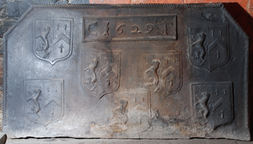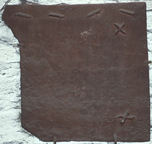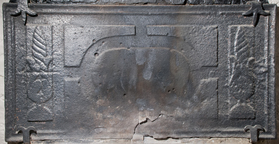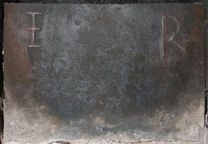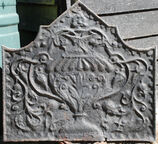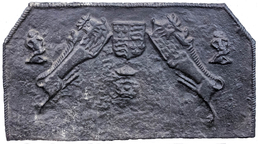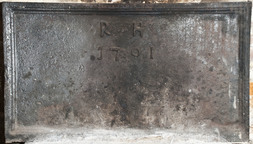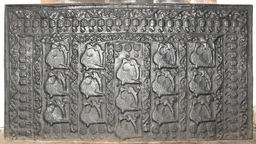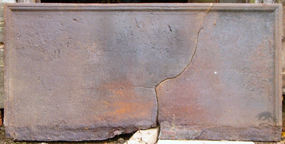-
30
Description: Rectangular, with canted top corners; twisted rope edging on top and sides; cavetto-moulded-edged rectangle top centre, enclosing date between initials; seven shields of Ayloffe impaling Sulyard; Ayloffe: sable, a lion rampant Or, collared gules, between three crosses formy of the second; Sulyard: argent, a chevron gules between three pheons inverted sable.
Notes: William Ayloffe (c.1535-1584) of Bretons, Hornchurch, Essex, Justice of the Court of Queen’s Bench, married (c1560) Jane, dau. of Sir Eustace Sulyard, of Runwell, Essex. A large number of variants use the same shields. The possibility that 'CT' was the founder Charles Tyler (d.1629/30) is reinforced by the fact that Poundsford Farm, Burwash, was owned by his grandson, also Charles, and subsequently by the latter's widow, Mary. The back was first noted at Poundsford in 1869.
Inscription: C 1629 T
Arms: Ayloffe impaling Sulyard (William Ayloffe of Bretons, Hornchurch)
- Decoration tags:
- rectangular with canted top corners (shape)
- rope (edging)
- carved stamps
- individual letters
- individual numbers
- planklines
- armorial
- text
Manufactured: in 1629 possibly at Hawkhurst Furnace in the Weald area of England.
Current location: Poundsford Farm, Burwash, East Sussex, England.
Citation: Gardner, J. S., 1898, 'Iron Casting in the Weald', Archaeologia, 56, 1, pp. 133-164.
Citation: Trower, C. F., 1869, 'Burwash', Sussex Archaeological Collections, 21, p. 113.
- Attached to series:
- Ayloffe series
- Personal armorial firebacks
-
31
Description: Fragment; rectangular plate with series of parallelogrammatic billets arranged across the top; crossed billets in corners
- Decoration tags:
- rectangular (shape)
- none (edging)
- simple stamps
Manufactured: possibly in the Weald area of England.
Current location: in private hands Burwash, East Sussex, England.
- Attached to series:
- Miscellaneous stamp firebacks
-
621
Description: Rectangular; ovolo moulded edging (top and sides); central shield, crest and mantling of the Fuller family. The date, of which the 1 is not visible, is split between the top corners of the shield and about two-thirds of the way down.
Notes: A carved armorial on a plain, edged base board; the arms of the Fullers of Brightling Park, Sussex, are: Argent, three bars and a canton gules; the crest; Out of a ducal coronet Or, a lion’s head argent. The Fullers were iron masters and gun founders in the first half of the 18th century, operating Heathfield furnace, where it is likely that this fireback was cast.
Copies of this fireback are known.
Inscription: [1] 7 / 4 7
Arms: Fuller, of Brightling, Sussex
- Decoration tags:
- rectangular (shape)
- ovolo (edging)
- carved pattern panels
- heraldic
- armorial
- text
Manufactured: in 1747 probably at Heathfield Furnace in the Weald area of England.
Current location: in private hands, Butleigh, Somerset, England.
- Attached to series:
- Ironmasters armorial series
- Personal armorial firebacks
-
1121
Description: Rectangular shape; cavetto-moulded edging; central abstract arrangement in low relief of a horizontally positioned oval surrounded by four separated spandrels forming a rectangular shape over all; at each side, on a raised rectangular field, a stylised bud or cone of helical form, within a calyx above a semi-circular base, one mirroring the other. A deep plankline is evident half way up the left plant.
Notes: An excrescence on the right side may have been caused by iron being poured from a ladle disturbing the casting sand. There are no parallels for this fireback design. The central abstract arrangement may be associated with a formal plan of a garden parterre, the stylised plants continuing that theme.
- Decoration tags:
- rectangular (shape)
- cavetto (edging)
- whole carved pattern
- planklines
- architectural
- plants
- objects
Manufactured: in the early- to mid-17th century in the Weald area of England.
Current location: in private hands, Buxted, East Sussex, England.
- Attached to series:
- Miscellaneous pattern firebacks
- Garden design types
-
221
Description: Rectangular; plain plate; inscription in capitals split between top corners, ‘I’ crossed.
Notes: The letters are likely to have been formed by tracing their shape in the casting sand using a pointed implement.
Inscription: I R
- Decoration tags:
- rectangular (shape)
- none (edging)
- individual letters
- text
Manufactured: in the early-17th century in the Weald area of England.
Current location: in private hands, Buxted, East Sussex, England.
- Attached to series:
- Initials only firebacks
-
1308
Description: Rectangular with cavetto curves rising to corners and a ‘pediment’ top; fillet edging with low-relief, alternate regularly-spaced semi-circles and triangles inside; two-handled flower vase with gadrooned top and symmetrical flower design; trailing vines and flowers issuing from top and descending through handles to base; human face at top; date split by vase base.
Notes: The style of the numerals includes a ‘1’ with hooked serifs.
Inscription: 16 52
- Decoration tags:
- rectangular with canted top corners and triangular arch (shape)
- scalloped fillet (edging)
- whole carved pattern
- pictorial
- text
- plants
- objects
Manufactured: in 1652 in the Weald area of England.
Current location: in private hands, Buxted, East Sussex, England.
- Attached to series:
- Gadrooned vase firebacks
- Hooked '1' series
- Brede group
-
125
Description: Canted rectangle; twisted rope edging (top and sides); top centre, Tudor royal shield between lion passant guardant to right and lion passant guardant sinister to left, both diagonally placed; below, a crowned rose; to left and right, an 'imp' with arms down, facing left.
Notes: One of a large series incorporating royal heraldic stamps. Canterbury Auction Galleries sale, 29 Nov 2017, lot 939 (£300).
Copies of this fireback are known.
Arms: Tudor royal arms of England
- Decoration tags:
- rectangular with canted top corners (shape)
- rope (edging)
- carved stamps
- heraldic
- armorial
- animals
- humans
Manufactured: in the mid-16th century in the Weald area of England.
Current location: not known.
Citation: Lloyd, N., 1925, 'Domestic Ironwork I', Architectural Review, 58, pp. 58-67.
- Attached to series:
- Royal series
-
1282
Description: Rectangular shape; wide fillet and ogee-moulded edging; approximately top centre, initials RH, with date 1701 centred below.
Notes: The character set for the initials and date lacks uniformity, some carved crudely, others more carefully; the lettering differs from another fireback (see no. 1166), with the same initials and date, by the position and shape of the letter 'R'. Formerly at Nethercote, Netherfield Hill, East Sussex. The former location in the Netherfield area of these two firebacks suggests a possible association with Richard Hay, owner of land in that area at that time and ironmaster at Beech Furnace nearby.
Inscription: R H / 1701
- Decoration tags:
- rectangular (shape)
- fillet and ogee (edging)
- carved stamps
- individual letters
- individual numbers
- text
Manufactured: in 1701 possibly at Beech Furnace, Battle in the Weald area of England.
Current location: in private hands, Catsfield, East Sussex, England.
- Attached to series:
- Date & initials firebacks
-
855
Description: Rectangular; twisted rope edging (top and sides); inner border of repeated strips of undulating vine tendril, inside of which are stamped panels of repeated grape bunches, totalling 27 along the upper edge and 13 down each side; inside them is a further border of vine strips within which are five columns of a bird stamp (probably a swan, a Lancastrian badge). each repeated three times, below each of which are three further grape bunch stamps except the middle column, where the grape bunches are above the swans.
Notes: A complex and well executed design incorporating three stamps found on many other firebacks.
- Decoration tags:
- rectangular (shape)
- rope (edging)
- carved stamps
- animals
- plants
Manufactured: in the late-16th century possibly at Pounsley Furnace, Framfield in the Weald area of England.
Current location: in private hands, Butleigh, Somerset, England.
- Attached to series:
- Pounsley series
- Vine strip series
- Swan series
- Furniture stamp firebacks
-
856
Description: Rectangular; ovolo-moulded edging (top and sides); otherwise plain.
Notes: A base board, possibly used for other firebacks.
- Decoration tags:
- rectangular (shape)
- ovolo (edging)
- whole carved pattern
Manufactured: in the 16th or 17th century possibly in the Weald area of England.
Current location: in private hands, Chailey, East Sussex, England.
- Attached to series:
- Base boards
